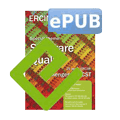by John Gialelis and Dimitrios Karadimas
SELIDA, a printed materials management system that uses radio frequency identification (RFID), complies with the Web-of-Things concept. It does this by employing object naming based services that are able to provide targeted information regarding RFID-enabled physical objects that are handled in an organization agnostic collaborative environment.
Radio Frequency Identification (RFID) technology has already revolutionised areas such as logistics (i.e., supply chains), e-health management and the identification and traceability of materials. The challenging concept of RFID-enabled logistics management and information systems is that they use components of the Electronic Product Code (EPC) global network, such as Object Naming Services (ONS) and the EPC Information Services (EPCIS) in order to support the Internet of Things concept.

Figure 1: The architectural framework of SELIDA.
SELIDA is a joint research project between the Industrial System Institute, the University of Patras (Library and Information Center), the Athens University of Economics and Business, Ergologic S.A and Orasys ID S.A. This project introduces an architectural framework that aims to support as many of the EPC global standards as possible (Figure 1). The project’s main goal is the ability to map single physical objects to URIs in order to provide, to all involved organizations in the value chain, various information related to these objects (tracking, status, etc). This is mainly achieved by SELIDA’s architectural framework which is able to support as many of the EPC global standards as possible (Figure 1) along with the realization of ONS-based web services available in the cloud. This architectural framework is a value-chain agnostic which relates to:
- the common logistics value-chain;
- the physical documents inter-change value-chain; and
- in demanding cases, the objects inter-change value-chain.
The discovery and tracking service of physical documents that has been implemented exploits both ONS 1.0.1 and EPCIS 1.0.1, in order to allow EPC tagged documents to be mapped to the addresses of arbitrary object management services (OMS), albeit ones with a standardised interface.
The main constituents of the architectural framework are:
- The RFID middleware which is responsible for receiving, analysing processing and propagating the data collected by the RFID readers to the information system which supports the business processes.
- The Integration Layer which seamlessly integrates the EPC related functions to the existing services workflow. While the existing legacy systems could be altered, such a layer is preferable because of the reliability offered by shop floor legacy systems in general.
- The ONS Resolver which provides secure access to the ONS infrastructure so that its clients can not only query the OMSs related to EPCs (which is the de facto use case for the ONS) but also introduce new OMSs or delete any existing OMSs for the objects.
- The OMS which provides management, tracking and other value added services for the EPC tagged objects. The ONS Resolver maps the OMS to the objects, according to their owner and type, and they should be implemented according to the EPCIS specification (see link below).
The SELIDA architecture has been integrated into KOHA, the existing Integrated Library System used in the University of Patras Library and Information Center. As with all integrated library systems, KOHA supports a variety of workflows and services that accommodate the needs of the Center. The SELIDA scheme focuses on a handful of those services and augments them with additional features. This is generally done by adding, in a transparent way, the additional user interface elements and background processes that are needed for the scheme to work. In order to provide the added EPC functionality to the existing KOHA operations, the integration layer was designed and implemented to seamlessly handle all the extra work, along with the existing service workflow. The SELIDA scheme provides additional functionality to services such as Check Out, Check In, New Record and Delete Record. There are also a number of tracking services that our scheme aims to enhance; these are History, Location and Search/Identify.
The implemented architecture focuses on addressing the issue of empowering the whole framework with a standard specification for object tracking services by utilising an ONS. Thus, the organisations involved are able to act agnostically of their entities, providing them with the ability to resolve EPC tagged objects to arbitrary services in a standardised manner.
Links:
KOHA: www.koha.org
ISO RFID Standards: http://rfid.net/basics/186-iso-rfid-standards-a-complete-list
Survey: http://www.rfidjournal.com/articles/view?9168
EPCglobal Object Name Service (ONS) 1.0.1:
http://www.gs1.org/gsmp/kc/epcglobal/ons/ons_1_0_1-standard-20080529.pdf
EPCglobal framework standards: http://www.gs1.org/gsmp/kc/epcglobal
Reference:
[1] J. Gialelis, et al.: An ONS-based Architecture for Resolving RFID-enabled Objects in Collaborative Environments”, IEEE World Congress on Multimedia and Computer Science, WCMCS 2013
Please contact:
John Gialelis or Dimitrios Karadimas
Industrial Systems Institute, Patras, Greece
E-mail address: {gialelis,karadimas}@isi.gr











